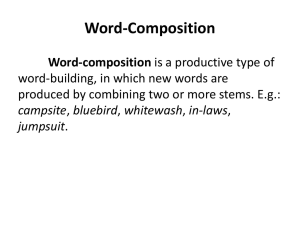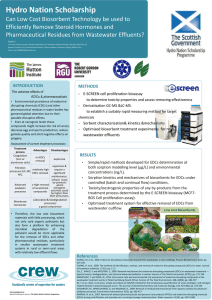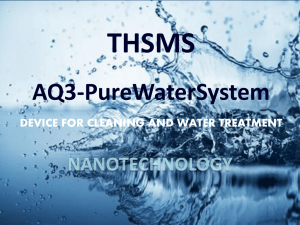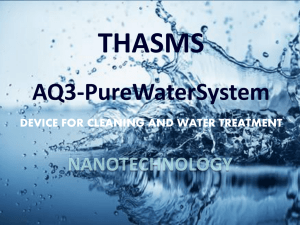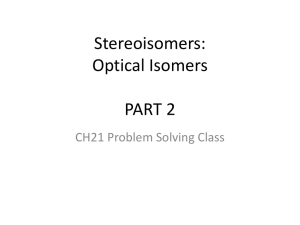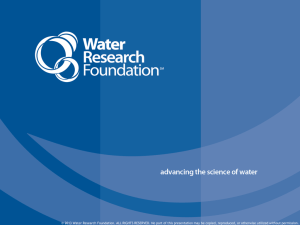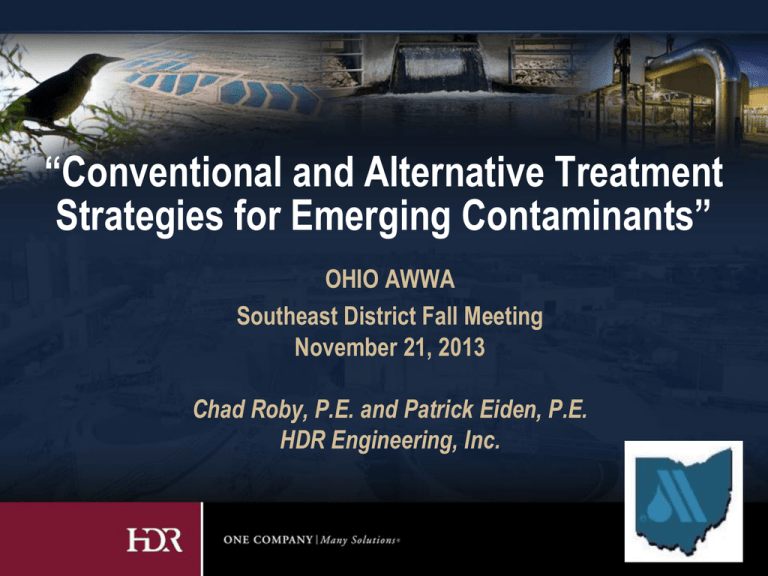
“Conventional and Alternative Treatment
Strategies for Emerging Contaminants”
OHIO AWWA
Southeast District Fall Meeting
November 21, 2013
Chad Roby, P.E. and Patrick Eiden, P.E.
HDR Engineering, Inc.
Agenda
Introduction
Emerging Contaminants
EDC/PCCPs, Perchlorate, Chromium, and NDMA
Health effects
Occurrence
Regulatory Issues
Contaminant Removal in Water Treatment Processes
Public Interactions
Conclusions
What are Emerging Contaminants?
USGS Definition:
“Emerging contaminants" can be broadly defined as any synthetic or
naturally occurring chemical or any microorganism that is not commonly
monitored in the environment but has the potential to enter the
environment and cause known or suspected adverse ecological and
(or) human health effects. In some cases, release of emerging chemical
or microbial contaminants to the environment has likely occurred for a long
time, but may not have been recognized until new detection methods
were developed. In other cases, synthesis of new chemicals or changes in
use and disposal of existing chemicals can create new sources of
emerging contaminants.
They Come from
“You”, not from
Wastewater
Treatment Plants
EPA Synopsis of Microconstituent Sources
Concept – Continuous Input of CECs
EDCs/CECs &
PPCPs
Domestic
Sewage
Runoff &
Seepage
WWTP
Reuse
Receiving
Water Bodies
Land
(Biosolids)
Ecosystems
WTP
Land
Application
Domestic
Water
Usage
What’s the EPA doing?
Contaminant Candidate List
• Regulation Determination
• Adverse health effects
• Occurrence
• “Meaningful opportunity” for
reducing risks to health
• CCL 1 (60 contaminants) March 1998
• CCL 2 (51 contaminants) February 2005
• CCL 3 (116 contaminants) October 2009
http://water.epa.gov/scitech/drinkingwater/dws/ccl/
CECs - EDCs/PPCPs (Microconstituents)
Endocrine Disrupting Compounds (EDCs) (DEET, TCEP)
Estrogens: regulate and sustain female sexual development and reproductive function
Androgen: male sex hormones
Mimics: estrogenic and androgenic compounds
Pharmaceuticals and Personal Care Products (PPCPs)
Non-steroidal anti-inflammatory
Anti-epileptic
Antibiotics
Anti-anxiety
Antioxidants
Pain reliever
Anti-cholesterol
Sun Screen
Why are EDCs/PPCP’s a Concern?
Direct impacts on ecological health
Well documented: feminization of fish, etc.
Direct impacts on human health?
Public perception and concern
A very sensitive issue
Indicator of antibiotic overuse?
Integrated Water Environment
Drinking Water, Wastewater and Reuse
Water Resources
CECs - EDCs/PPCPs are Present in
Source Waters …
USGS Surface Water
Survey (2000)
30 States
139 Streams
Sample for 95
compounds
Kolpin et al 2002
At least one compound
detected in 111
streams (80%)
82 of 95 compounds
detected at least once
ORSANCO/EPA Study
158 compounds measured
Report: 2010
Feminized Fish are Found Throughout the
United States
Nine river basins
Mississippi
Columbia
Rio Grand
Yukon
Colorado
Mobile
Apalachicola
Savannah
Pee Dee
Large and small mouth bass
Feminization found
25% of fish species
31% of sites
Hinck et al 2009
EDCs and PPCPs in US Drinking Waters
Snyder, et. al, 2008
How Effective Are Our Treatment
Plants at Removing Contaminants of
Emerging Concern
WRF Study on EDCs and Related Compounds – WRF
4162
Target Compounds
EDCs
N-N-diethyltoluamide (DEET)
Pharmaceuticals
Atorvastatin (weight loss)
Tris(2-chloroethyl)phosphate
(TCEP) (flame retardant)
Estrone (estrogen)
Naproxen (arthritis)
Perchlorate
WW Associated
N-Nitrosodimethylamine
(NDMA)
Sulfamethoxazole
(antibiotic)
Trimethoprim (urinary tract)
Atenolol (blood pressure)
Ranitidine (ulcers, GERD)
Ciprofloxacin (antibiotic)
Umass Bench scale study
Some EDC’s are Currently Regulated
Examples:
Pesticides: atrazine, chlordane, DDT, endrin, lindane,
methoxychlor, simazine, and toxaphene
Nonpesticide organics: benzo(a)pyrene, bis(2-ethyhexyl)
phthalate, dioxin, and PCBs
Inorganic chemicals: cadmium, lead, and mercury
Values are based on toxic or cancer effects
Groundwater with Chlorine Disinfection
Good removal except for DEET and TCEP
Groundwater II – Prechlorination/Filtration,
Aeration/Post Chlorination
Good removal of most compounds except TCEP
110
100
90
Percent Remaining
80
Atenolol
Ranitidine
Sulfamethoxazole
Trimethoprim
Ciprofloxacin
DEET
Naproxen
TCEP
Atorvastatin
Naproxen-Neg
70
60
50
40
30
20
10
0
filtered
finished
Treatment
Surface Water – Conventional Treatment with
GAC Filtration, Pre/Post Chlorination
Good removal of most compounds except TECP
110
100
90
Percent Remaining
80
Atenolol
Ranitidine
Trimethoprim
Estrone
DEET
TCEP
Atorvastatin
70
60
50
40
30
20
10
0
settled
filtered
Treatment
finished
Surface Water - Conventional Treatment with
Anthracite/Sand Filtration, Pre/Post Chlorination
Mostly good removal except DEET, TCEP
Surface Water – Ozone/Biofiltration
(WRF 4162)
Unregulated Contaminant Removal at FullScale WTPs
Coagulation/Flocculation – Minimal
contaminant removal 2 out of 37
compounds @ 75%
Filtration alone – minimal
contaminant removal 4 out of 32
compounds @ 75%
Ozone – Effective 15 compounds
transformed at > 70%
GAC – 8 of 28 compounds
removed at greater than 75%, 11
other compounds removed to a
moderate degree
WRF #4221, 2013
Unregulated Contaminant Removal at FullScale WTPs
Other Observations
Source water with more NPDES permit
More contaminants detected
Greater mass of containments
Size of watershed
Hydrology plays important role in detection
WRF #4221, 2013
Path Forward?
Water utilities presently face a dilemma when
trying to proceed with planning
Lack of firm scientific consensus on the importance of
drinking water as a route of exposure for these
compounds
Regulatory evaluations underway
No clear path for utilities
10,000 chemicals - Endocrine Disruptor Screening
Program (EDSP)
Even effective treatment doesn’t capture all
compounds
EDCs and PPCPs - Removal by Advanced
Treatment Processes
Granular Activated Carbon Filtration
Can be effective if run in “adsorption mode”
Expensive
Ozonation and Biofiltration
Can be effective if filters operate biologically
Membranes
Only the high pressure types are effective (e.g.,
reverse osmosis)
Expensive if just used for PPCPs
Advanced Oxidation (ozone/UV and peroxide)
Expensive and only slightly more effective than
ozone alone
Other Prominent Microconstituents
Perchlorate – Can occur naturally but most
environmental release associated with solid rocket
fuel
Hexavalent Chromium
N - Nitrosodimethylamine (NDMA)
Perchlorate is the most oxidized form of Cl2
ClO4- +2H+ + 2e- => ClO3- + H2O Eº +1.20 V
ClO4- +8H+ + 8e- => Cl- + 4H2O Eº +1.38 V
Uses
Explosives
Fireworks
Medicinal (hyperthyroidism)
Analytical chemistry
Primary health effect:
Interferes with iodine uptake
into the thyroid gland
UCMR - Perchlorate
Occurrence by PWS
as of August 2004
• Natural and manmade sources
• Low levels detected in 26 states
Perchlorate Regulatory Status
No MCL or MCLG
Regulations in progress
Directed sampling
Several states, including Arizona, Maryland, Nevada,
New Mexico, New York, and Texas have established
non-enforceable, advisory levels for perchlorate
Comprehensive Environmental Response, Compensation
and Liability Act (CERCLA)
Basic Approaches Treatment of Perchlorate in
Drinking Water
ClO4Contaminated
Water
ClO4Contaminated
Water
Resin
Electron
Donor
Dispose
ClO4Contaminated
Water
ClO4Contaminated
Water
Uncontaminated
Water
Concentrate
Or
ClO4Brine
Treated
Water
Dispose
Destruction
Biomass
Filtration
Disinfection
Destruction Methods:
Biological Reduction
Catalyzed Thermal
Treated
Water
Treated
Water
Blending
Reverse
Osmosis
Treated
Water
Ion Exchange
Biological Reduction
(fixed and fluidized
bed)
Chromium: General Information
Symbol
Discovered in
Atomic Number
Cr
1797
24
Atomic Weight
Oxidation States
Uses
51.9961
6, 3, 2, 0
Harden steel
Plating
Catalyst
Pigments
Dietary supplement
Typical source
Chromite (FeCr2O4)
Summary of Cr(VI) Health Effects
National Toxicology Program (NTP) found evidence of Cr(VI)
carcinogenicity in rats
CA OEHHA established Public Health Goals (PHG) based
on NTP findings (draft)
USEPA has proposed a revision to Integrated Risk
Information System (IRIS) based on NTP findings
ToxStrategies Mode of Action Study indicates lower risk of
cancer by ingestion than assumed by OEHHA or USEPA
Current Regulatory Status for Chromium
Current standards for total chromium
[Cr(III) + Cr(VI)]
USEPA MCL = 100 µg/L (0.1 mg/L)
California MCL = 50 µg/L
WHO Standard = 50 µg/L
No federal regulation (MCL) for hexavalent
chromium (Cr(VI))
California Public Health Goal for Cr(VI) – 0.02 µg/L
Potential adverse health effects due to Cr(VI) NOT
Cr(III)
Chromium Detection Locations
Reference
USEPA
Total Chromium
Ohio (Region 5)
Ref: Seidel, 2011
Potential Treatment Technologies
Cr(VI)
EDR
Reduce or Oxidize
Anion
Membrane
Exchange
Adsorption
Cr(III)
Electro
Coagulation
Precipitate
No
Treatment
Soften
Deposit on
Surface
Filter Coagulate/
Co-precipitate
Filter
Delivered water Cr(VI) only
Delivered water Cr(III) only
Potential oxidation to Cr(VI) in
distribution system
Easier to Reduce Cr(VI) to Cr(III) than Oxidize
Cr(III) to Cr(VI)
NDMA
N - Nitrosodimethylamine (NDMA)
CH3
O = N-N
CH3
Polar, highly soluble and semi-volatile
Degrades in the presence of sunlight
Particularly sensitive to ultraviolet radiation
NDMA Sources
An intermediary in the production of storable rocket fuel
Production ceased in 1976
Has been found in ground waters not impacted by rocket fuel
production.
Variety of chemical processing applications particularly plastic
Present in cured meat and others foods (beer, sausage, etc.)
By-products from water treatment, particularly disinfection with
chloramines
NDMA Formation During Drinking
Water Treatment
By-product of disinfection with chlorine/monochloramine
Generally thought monochloramine will produce more NDMA
NDMA formation has been associated with
Anion exchange resins
Dimethylamine (DMA) containing polymers
Systems with nitrification
Presence of nitrogen
with oxidant
Wastewater effluent organic matter (EfOM)
Evidence of continued formation in distribution system
NDMA – Cancer Effects
NDMA Results from UCMR2
63% from surface water
Russell et all, JAWWA 2012
NDMA to regulate or not?
• Adverse health effects?
• Occurrence?
• “Meaningful opportunity” for reducing risks to health?
US EPA will probably regulate. Possibly
with an action level.
NDMA Minimization/Treatment
Small size and high solubility make NDMA difficult to treat by
conventional means
Add chlorine prior to ammonia
Precursor control through treatment of organic nitrogen
Preoxidation with chlorine, chlorine dioxide or ozone can
destroy or transform NDMA precursors
UV or advanced oxidation (UV/peroxide) treatment
Take advantage of NDMA instability in presence of UV
0
Monitoring
well
Final
Product
Water
UV Effluent
Post H2O2
RO
Permeate
MF Effluent
ppt
NDMA Profile Through Treatment Plant
70
60
50
40
30
20
10
Public Perception
Public Perception The Terminology Can Create or Exacerbate Fears
Endocrine disrupting compounds
Compounds of emerging concern
Compounds of potential concern
EPOCs — emerging pollutants of concern
Emerging contaminants of concern
PPCPs --- Pharmaceuticals and Personal Care Products
CEPs – Compounds of Emerging Publicity (Shane Synder)
Even the word ‘chemical’ implies danger to the public
What should we say?
Ensure understanding, without getting overly technical
Industry professionals should convey their commitment to
advancing understanding of this issue
Use appropriate terminology and take care not to cause alarm
Gently demonstrate that the “source” is all of us, and the
solution is not just at the wastewater treatment plant
Public Service Advertisements about proper disposal of drugs and
chemicals
Household hazardous waste disposal events
Drug take back programs
National Prescription Drug Take-Back Day
The National Prescription Drug Take-Back Day
aims to provide a safe, convenient, and
responsible means of disposing of prescription
drugs, while also educating the general public
about the potential for abuse of medications.
You can search by zip code for a collection site
near you. Inquiries can also be made at 1-800882-9539.
http://www.deadiversion.usdoj.gov/
drug_disposal/takeback/index.html
Public Perception - Communication is Key!
We need to promote greater public understanding about
their water environment in a way that neither creates
undue alarm nor complacency
Residual amounts of the substances we use are likely to
end up in the water environment even though it may be
at nearly undetectable levels
Concentration, duration, and dose are MORE
IMPORTANT than detection
Conclusions
CECs are present in water
environment
Human health impacts still
developing
Environmental effects
Conventional treatment works well
for many compounds
Communication is KEY
Resources
USGS
http://toxics.usgs.gov/regional/emc/index.html
US EPA
http://www.epa.gov/endo/
ORSANCO
http://orsanco.org/
HDR EDC/CEC/PPCP Task Force
Integrated Water Environment
Drinking Water, Wastewater and Reuse
Water Resources
Scientists used florescent dye and bromide to track river water
to which two emerging contaminants had been added - 4nonylphenol and 17β-estradiol. This allowed the scientists to
study the natural attenuation of the two compounds as they
were transported down the Redwood River, Minnesota. Photo
credit: Jeffrey H. Writer, USGS.
Questions?
Resources
USGS
http://toxics.usgs.gov/regional/emc/index.html
US EPA
http://www.epa.gov/endo/
ORSANCO
http://orsanco.org/
HDR EDC/CEC/PPCP Task Force
Integrated Water Environment
Drinking Water, Wastewater and Reuse
Water Resources
Contact:
Chad Roby, P.E.
chad.roby@hdrinc.com
614-839-5771
Patrick Eiden, P.E.
patrick.eiden@hdrinc.com
614-839-5781



